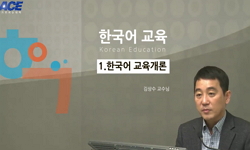This article aims to consider the pronunciation types of consonantal sequences, and to propose a teaching plan for Korean as a foreign language by taking advantage of them. The pronunciation of consonantal sequences is considered by dividing them into...
http://chineseinput.net/에서 pinyin(병음)방식으로 중국어를 변환할 수 있습니다.
변환된 중국어를 복사하여 사용하시면 됩니다.
- 中文 을 입력하시려면 zhongwen을 입력하시고 space를누르시면됩니다.
- 北京 을 입력하시려면 beijing을 입력하시고 space를 누르시면 됩니다.
부가정보
다국어 초록 (Multilingual Abstract)
This article aims to consider the pronunciation types of consonantal sequences, and to propose a teaching plan for Korean as a foreign language by taking advantage of them. The pronunciation of consonantal sequences is considered by dividing them into two groups; namely the case of no phonological changes such as Chinese and Vietnamese, and the case of consonantal assimilation such as Japanese, English, Hindi, and Korean. The consonantal assimilation is discussed in terms of the place of articulation and the manner of articulation. The former is quite common in languages, whereas the latter is not. Korean has both processes, even if the pronunciation with the application of place assimilation is not regarded as standard Korean. The consonantal assimilation in terms of manner of articulation in Korean appears to be nasalization and lateralization. Since the processes, both nasalization and lateralization, are marked compared to other languages, and the phonological environment of the two processes is so complex, Korean language learners may have some difficulty in the acquisition of Korean. Therefore, it is strongly recommended that teachers present the data which are involved with consonantal assimilation one by one, and provide explanations to the learners by contrasting the target language, Korean, and the learner’s native language.
참고문헌 (Reference)
1 김선정, "한국어 자음 연쇄의 분포 특성에 관한 연구" 한국언어문화교육학회 4 (4): 81-95, 2008
2 권현주, "특수음소의 변이음을 이용한 한국어 종성 발음 인지교육 방안-일본어권 학습자를 대상으로-" 한국일본어문학회 31 (31): 35-54, 2006
3 이세창, "유표성제약의 분할 필요성에 관한 연구: 한국어와 영어에 나타난 조음위치동화의 비교분석을 중심으로" 한국음운론학회 13 (13): 539-558, 2007
4 허용, "영어 단어 구조를 이용한 한국어 음운변동의 발음교육 원리" 한국외국어교육학회 14 (14): 293-310, 2007
5 Kim, S. J., "Unreleasing: the case of neutralisation of Korean, In Living on the Edge Studies in Generative Grammar" 497-510, 2003
6 Vance, Timothy, "The Sounds of Japanese" Cambridge University Press 2008
7 Lin, Yen-Hwei, "The Sound of Chinese" Cambridge University Press 2007
8 Kim, S. J, "The Representations of Korean Phonological Expressions and Their Consequences" University of London 1996
9 Harris, John, "Segmental Complexity and Phonological Government" 7 (7): 255-300, 1990
10 Brown, Douglas, "Principles of Language Learning and Teaching" Prentice-Hall 1994
1 김선정, "한국어 자음 연쇄의 분포 특성에 관한 연구" 한국언어문화교육학회 4 (4): 81-95, 2008
2 권현주, "특수음소의 변이음을 이용한 한국어 종성 발음 인지교육 방안-일본어권 학습자를 대상으로-" 한국일본어문학회 31 (31): 35-54, 2006
3 이세창, "유표성제약의 분할 필요성에 관한 연구: 한국어와 영어에 나타난 조음위치동화의 비교분석을 중심으로" 한국음운론학회 13 (13): 539-558, 2007
4 허용, "영어 단어 구조를 이용한 한국어 음운변동의 발음교육 원리" 한국외국어교육학회 14 (14): 293-310, 2007
5 Kim, S. J., "Unreleasing: the case of neutralisation of Korean, In Living on the Edge Studies in Generative Grammar" 497-510, 2003
6 Vance, Timothy, "The Sounds of Japanese" Cambridge University Press 2008
7 Lin, Yen-Hwei, "The Sound of Chinese" Cambridge University Press 2007
8 Kim, S. J, "The Representations of Korean Phonological Expressions and Their Consequences" University of London 1996
9 Harris, John, "Segmental Complexity and Phonological Government" 7 (7): 255-300, 1990
10 Brown, Douglas, "Principles of Language Learning and Teaching" Prentice-Hall 1994
11 Eckman, Fred, "Markedness and the Contrastive Analysis, In Interlanguage Phonology: The Acquisition of a Second Language Sound System" 56-69, 1987
12 Major, Roy, "Markedness Universals and the Acquisition of Voicing Contrasts by Korean Speakers of English" 18 (18): 69-90, 1996
13 Heo, Y, "How to Teach Korean Pronunciation as a Foreign Language" Parkleejung Publishers 2006
14 Choi, J. C., "Hindi Phonology" Hankuk University of Foreign Studies Publishers 2003
15 Rhee, S. J., "Empty Nuclei in Korean" Leiden University 2002
16 Heo, Y, "Empty Categories and Korean Phonology" University of London 1995
17 An, S. C, "Contrastive analysis of English and Korean" Hankuk Publishers 2006
18 Heo, Y, "Contrastive Linguistics" Sotong 2013
19 Kim, S. J., "A study on the characteristics of Korean final consonants of Chinese learners’ pronunciation: Focusing on the characteristics by proficiency stage" Keimyung University 2013
20 Boonmalerd Kronnapha, "A study on how to teach Korean pronunciation for Thai learners: Focusing on final consonant" Keimyung University 2013
21 Harris, John, "A Tale of Two Cities: London Glottaling and New York City Tapping" 7 (7): 251-274, 1990
22 Heo, Y., "A Government Approach to the Consonantal Assimilation in Korean" 34 : 199-213, 2004
23 Chau Thi Thu Thuy, "A Contrastive Study on Phonology between Korean and Vietnamese" Yeungnam University 2011
동일학술지(권/호) 다른 논문
-
EVIDENTIALITY, PAST, AND PERSON IN MONGOLIAN AND KOREAN
- 계명대학교 한국학연구원
- 송재목
- 2013
- KCI등재,AHCI,SCOPUS
-
- 계명대학교 한국학연구원
- 이정환
- 2013
- KCI등재,AHCI,SCOPUS
-
An Analysis and Interpretation of Korean Vowel Systems
- 계명대학교 한국학연구원
- 허용
- 2013
- KCI등재,AHCI,SCOPUS
-
A Study of the Korean Clausal Connectives ‘-ŏsŏ’ and ‘-ko’ of Temporal Sequence
- 계명대학교 한국학연구원
- 박동호
- 2013
- KCI등재,AHCI,SCOPUS
분석정보
인용정보 인용지수 설명보기
학술지 이력
| 연월일 | 이력구분 | 이력상세 | 등재구분 |
|---|---|---|---|
| 2023 | 평가예정 | 해외DB학술지평가 신청대상 (해외등재 학술지 평가) | |
| 2020-01-01 | 평가 | 등재학술지 유지 (해외등재 학술지 평가) |  |
| 2012-02-27 | 학회명변경 | 영문명 : institute of korean studes -> Academia Koreana |  |
| 2010-01-01 | 평가 | 등재학술지 선정 (등재후보2차) |  |
| 2009-01-01 | 평가 | 등재후보 1차 PASS (등재후보1차) |  |
| 2007-01-01 | 평가 | 등재후보학술지 선정 (신규평가) |  |
학술지 인용정보
| 기준연도 | WOS-KCI 통합IF(2년) | KCIF(2년) | KCIF(3년) |
|---|---|---|---|
| 2016 | 0.3 | 0.27 | 0.27 |
| KCIF(4년) | KCIF(5년) | 중심성지수(3년) | 즉시성지수 |
| 0.35 | 0.31 | 0.676 | 0.05 |






 KCI
KCI





